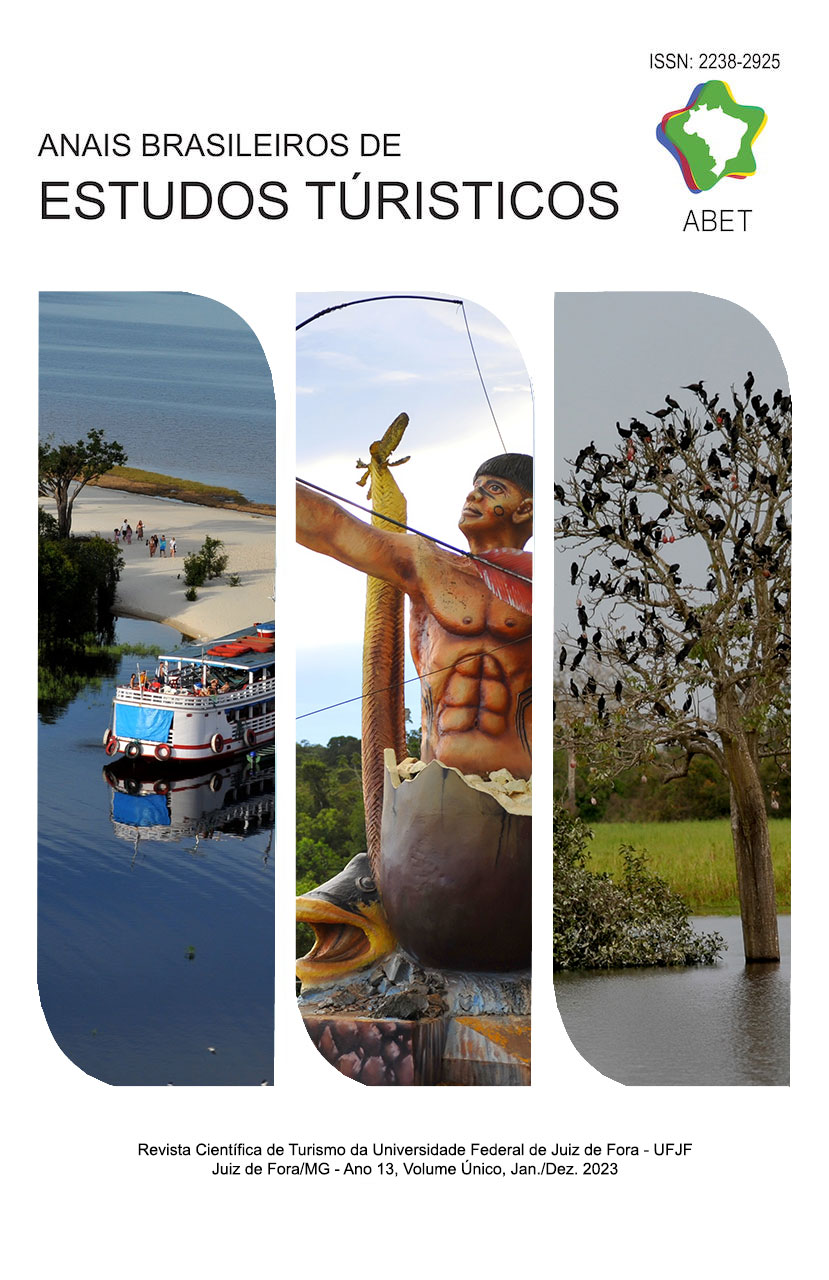Impacto do cinema no turismo: o caso do Brasil
DOI:
https://doi.org/10.5281/zenodo.7630420Palavras-chave:
Cineturismo, Cinema e território, Locations in BrazilResumo
A importância deste trabalho reside no fato de que cada vez mais, o setor de turismo se prepara para atingir dois dígitos em sua participação no produto interno bruto mundial, somado ao fato de que, em países como o Brasil, seus vínculos produtivos afetam a dinâmica espacial de as localidades. Portanto, este artigo tem como objetivo desenvolver um cartograma dos lugares filmados no Brasil, documentar as potencialidades fílmicas de cada ente federativo da República brasileira e, assim, contribuir com elementos para caracterizar o rumo que as diferentes agendas podem seguir. Turismo da Federação. Ressalta-se que o tratamento metodológico é um esforço de abordagem do fenômeno Big Data, a busca foi realizada por meio de quatro milhões de títulos de filmes. Entre os resultados mais prementes, dependendo do gênero cinematográfico, a vaga de referência das locações brasileiras varia, por exemplo, se o gênero é ficção científica, destaca-se o caso de Salvador de Bahia, ao invés do gênero documental destaca o estado do Pará.
Downloads
Referências
Aertsen, V. U. (2011). Cinema as an inducer of tourism. The tourist experience in Vicky, Cristina, Barcelona. Reason and word, (77), 53.
Borges, S., and Godoy, K. (2012). A favela tourist and cinematographic aesthetic: supports of a built authenticity. Virtual Tourism Directory, 12 (2), 239-252.
Brizuela, B. (2009). Mexico as a destination of locations for the world and its benefits to tourism. Mexico: Exhibition Floor.
Campos, J. L., Gomes, C. L., y Fonseca, J. L. (2020). Atuação das Film Commissions da Região Sudeste do Brasil: Interfaces com o Turismo Cinematográfico. Marketing & Tourism Review, 5(1). DOI: 10.29149/mtr.v5i1.5882.
Carvalho, S., Lima, A., y Pereira, A. M. (2014). Film-induced tourism: The case of Portugal. Revista Turismo & Desenvolvimento, 4(21/22), 469-482.
Croy, W. G., and Walker, R. D. (2003). Rural tourism and film-issues for strategic regional development. New Directions in Rural Tourism, 115-133.
Croy, W. G. (2010). Planning for film tourism: Active destination image management. Tourism and Hospitality Planning & Development, 7 (1), 21-30.
Croy, G. W. (2011). Film tourism: sustained economic contributions to destinations. Worldwide Hospitality and Tourism Themes, 3 (2), 159-164
Chon, K. S. (1990). The role of destination image in tourism: A review and discussion. The tourist review, 45(2), 2-9.
De Santana L. C., y De Lima, J. R. (2015). Characterization of tourism clusters in Brazil. Tourism Economics, 21(5), 957-976.
Drago, Alejandro. (nineteen ninety five). The macroeconomic impact of tourism: an econometric model of tourism supply and demand in Mexico (1960-1989). Mexico: the author, undergraduate thesis, School of Economics, Universidad Panamericana.
Fonseca, J., Gomes, C. (2020). O Turismo Induzido por Filmes no Contexto Latino-Americano: Uma Revisão Sistemática de Literatura. Rosa dos Ventos, 12(3), 657-682.
Fridgen, J. D. (1984). Environmental psychology and tourism. Annals of Tourism Research, 11(1), 19-39.
Gunn, C. A. (1988). Vacationscape: Designing tourist regions. New York: Van Nostrand Reinhold.
Kim, H., y Richardson, S. L. (2003). Motion picture impacts on destination images. Annals of Tourism Research, 30(1), 216-237.
Lemus, Victor. (1973). The tourist potential of the Baja California territory. Mexico: the author, bachelor's thesis, Faculty of Accounting and Administration, National Autonomous University of Mexico.
Mayo, Edward J. (1973), "Regional Images and Regional Travel Behavior", Proceedings…. of the Travel Research Association Fourth Annual Conference, pp. 211-218.
Millán, Á., García, J. A., y Díaz, E. (2016). Film-induced tourism: A latent class segmentation based on satisfaction and future intentions. Pasos Revista de Turismo y Patrimonio Cultural, 14(4), 875-888.
Rangel, Rosa. (2001). Evaluation and development of tourism activity in Mexico, 1991 - 2001. Mexico: the author, undergraduate thesis, National School of Professional Studies Aragon, National Autonomous University of Mexico.
Sámano, Carlos. (1973). Tourism development in the territory of Quintana Roo. Mexico: the author, undergraduate thesis, Higher School of Economics, National Polytechnic Institute.
Savigliano, M. (2005). Destination Buenos Aires: tango-cinematographic sexual tourism. Cadernos Pagu, (25), 327-356.
Tovar, R and Alvarado, C. (2010). Xochitepec. A proposal for comprehensive cultural tourism development. The Sustainable Journey, (19): 93-121.
Urry, J. (2002). The Tourist Gaze. Londres: Thousand Oaks.
Vázquez, S. (2013). Analysis of health and quality of life in older adults in two climatic zones of Veracruz. Universidad Veracruzana, Institute of Public Health, Universidad Veracruzana. Xalapa: Veracruzana University.
Vieira, D. P., Teixeira, E., & da Silva Neto, P. (2022). Impact Assessment of Brazil’s International Tourism Promotion Policy. Revista Anais Brasileiros De Estudos Turísticos, 12(1). https://doi.org/10.5281/zenodo.7262460
Downloads
Publicado
Como Citar
Edição
Seção
Licença
Copyright (c) 2023 Anais Brasileiros de Estudos Turísticos

Este trabalho está licenciado sob uma licença Creative Commons Attribution 4.0 International License.
Todo o conteúdo desta revista (ABET), entre 2011 e 2018, foi licenciado por Creative Commons, Atribuição Não Comercial / Sem Derivações / 4.0 / Internacional (CC BY-NC-ND 4.0). A partir de 2019, o tipo de licença que a revista passou a adotar é Creative Commons 4.0 / Internacional (CC BY 4.0).
Portanto, os autores concordam que as obras publicadas nesta revista estão sujeitas aos seguintes termos:
1. A Universidade Federal de Juiz de Fora, por meio do seu Observatório Econômico e Social do Turismo (OEST), aqui denominado como o editorial, conserva os direitos patrimoniais (direitos autorais) das obras publicadas.
© Observatório Econômico e Social do Turismo (OEST), Universidade Federal de Juiz de Fora (UFJF), 2019.
2. Pode-se copiar, usar, difundir, modificar, transmitir, expor publicamente, e inclusive usar para fins comerciais, desde que: i) seja citada a autoria e a fonte original de sua publicação (revista, editorial e URL da obra); ii) seja mencionada a existência e as especificações desta licença de uso.
POLÍTICA DE PRIVACIDADE
Os nomes e endereços informados nesta revista serão usados exclusivamente para os serviços prestados por esta publicação, não sendo disponibilizados para outras finalidades ou a terceiros.















